Bougainvillea Care Tips For This Flowering Machine
If you live in a temperate climate and want an (almost) year-round floral fiesta of vibrant color, then bougainvillea is the plant for you. I’m sharing bougainvillea care tips, a plant I have a lot of experience with, in two different hardiness zones.
There are many different types of bougainvillea. Depending on the variety, it can be grown on a trellis or over an arbor, against a building, fence, or wall, in containers, as a hedge or ground cover, in tree form, and as a bonsai.
Bougainvillea species and varieties can grow from 1′ to 8′ to 30′. There are quite a few dwarf varieties of bougainvillea (not really dwarf, but they stay under 6′) on the market now if you don’t want the maintenance that goes along with one that grows to 25′.
These are the bougainvilleas I’ve seen most often: Barbara Karst, San Diego Red, Rosenka, James Walker, Torch Glow, and Purple Queen.
Another name you might see bougainvillea called: Bugambilia.
Bougainvillea Care Tips

I’ve grown bougainvillea in 2 different climate zones. I lived in Santa Barbara, CA (USDA zone 10b) for ten years. I moved to Tucson, AZ (USDA zone 9a) seven years ago.
Growth Rate
If bougainvillea is in the right conditions, then it’s fast-growing. If it’s not getting enough sun, the growth will be leggy, and you won’t get much flowering.
Bougainvillea is fast-growing after it gets established in the warmth and full sun that it loves. I’ve found it takes one to three years for new plants to take off, but when they do, they’re off to the races!
Cold Tolerance
This flowering machine isn’t a plant for colder climates.
Bougainvillea is hardy from USDA zones 9b – 11. It doesn’t like to go below 32 degrees Fahrenheit and not for a prolonged period. One or two random nights around or slightly below freezing will be okay. You can find your USDA hardiness zone here by inputting your zip code.
Older, established bougainvilleas can withstand a freeze much better than newly planted ones. Many varieties will lose part or all of their leaves in climates with winters on the cooler end of the spectrum.
Some of the foliage from the previous season can remain on the plant and eventually falls off as new growth appears in spring.

Sun Requirements
Bougainvillea needs at least 6 hours of full sun daily to flower profusely and look its best. This plant also loves the heat. Not enough sun = not enough color.
If you live in a climate where bougainvillea is borderline hardy, planting it against a warm wall or in a corner against the house will help. Remember, this popular plant that loves sun and heat!
Got questions about growing bougainvillea? We’ve got the answers!
Check out our in-depth Bougainvillea Guide, designed to help you grow this beautiful plant with confidence. Click the link to learn more. Happy growing!
Watering
When it comes to watering, bougainvillea is fairly drought-tolerant once established. It prefers a good, deep watering every 3-4 weeks rather than frequent shallow watering.
Give your bougainvillea regular water when establishing (in the first couple of years). It’s subject to a few types of root rot, so don’t over-water. The soil should be well-drained, helping to prevent rot.
I never supplementally watered my bougies in Santa Barbara because they were older and well-established. I lived seven blocks from the beach, so they got spring and summer moisture from the maritime layer.
In Tucson, my bougainvilleas look best when watered (via drip irrigation) for an hour a week in spring, summer, and early fall.
Another result of too much water – is more green growth and fewer flowers. No, thank you – flowers, please!
Do you have questions about this plant? Click here for answers to questions about Growing Bougainvillea.

Fertilizer
I’ve never fertilized bougainvilleas when planting or as part of maintenance. I feed them with compost – a good dose upon planting and a 3″ topping every year or two in late winter/early spring.
I used to work at a Berkeley Horticultural Nursery, where a grower recommended fertilizing them with palm and hibiscus food one or two times (in late spring and mid-summer) during the active growing season. This bougainvillea fertilizer gets high ratings and would be another option.
Be sure to follow the directions on the box – an application once or twice a year will be just fine.
Pests
In my Santa Barbara garden, aphids could be an issue on the new growth of my bougainvilleas in early spring. I just sprayed them off with a gentle blast of the garden hose. Spider mites are another common plant pest to be on the lookout for.
The bougainvillea looper caterpillar has been an issue with my bougies in Arizona and California. They’re green, brown, or greenish-yellow and tiny – maybe 1″ long. They feed at night and chew mainly on the leaves. I just let them be, and they eventually go away. Because my bougies drop many leaves in the winter, it’s not an issue for me.
A few years ago, leafcutter bees enjoyed one of my bougainvilleas, which you’ll see in the video, but now they moved on. They move fast and are valuable pollinators for many plants. For that reason, I let them be, also.
You might find this post on What’s Eating My Bougainvillea Leaves helpful.

Soil
This plant needs well-draining soil when growing in the ground or in a pot. Find more on bougainvilleas in containers further on down.
When I plant bougainvilleas in the ground, I add loam from a local landscape supply company (if the existing soil needs it) and organic matter.
Transplanting/Planting
Planting or transplanting bougainvillea is best done in the warmer months. Depending on your zone, that’s anywhere from March through October.
One of the most important things to do is to choose the appropriate location. Bougainvilleas and sunshine go hand in hand.
I’ll briefly touch on transplanting and tell you it’s a crapshoot. Bougainvilleas don’t like to have their roots disturbed. I’ve never transplanted one and don’t recommend it.
You’d be better off just buying a new plant. If you try transplanting yours, just be as careful as possible not to injure those sensitive roots.
I’ve done a post and video on Planting Bougainvillea, which includes all the steps and an important thing to know.

Supporting/Training
The taller growing bougainvillea vines need strong support and require training and to be tied. They aren’t attaching or twining vines. Make sure the ties you use are strong and that you tie them well – some of their branches get to be good-sized.
I trained my Bougainvillea glabra in Santa Barbara to grow up and over my garage. Once it got higher than the door, I secured it to a large metal trellis (bolted to the top center of the garage), and it grew all the way across. You can see this in the photo below.
They can be trained on a trellis, over an arbor, on a fence, or across a structure. The lower-growing varieties are suited to be hedges, ground covers, and free-form shapes (I’ve seen one pruned into a swan shape and another into a giant basket).
The best time to start the training process is when or soon after planting.
I trained my Barbara Karst in Santa Barbara into an “umbrella tree.” Bougainvilleas are also suitable bonsai plants; I’ve seen some beautiful specimens.
Pruning
I gave mine their big pruning in late winter in Santa Barbara and early spring in Tucson. This sets the tone for how I wanted them to grow and look throughout the season. I did two or three lighter prunes after each bloom cycle.
Bougainvillea blooms on new growth. You want to prune and pinch yours to bring on the flowering. If you pinch the tender ends, which are about to bloom, the show of color will be denser and not all at the ends.
A word of warning: all bougainvilleas I’ve come across have sharp thorns, so use caution and wear gloves when pruning. If you’re not careful, you can come out from a round of pruning looking like you’ve been in the lion cage!
I’ve done five posts and videos on how to prune bougainvillea in this round-up: Bougainvillea Pruning Tips: What You Need to Know.

Bougainvillea In Containers
I’ve written dedicated posts about planting bougainvillea in pots and bougainvillea care in pots which you’ll find below.
It does fine in containers, but I’d recommend using one of the lowing growing varieties of bougainvilleas for this.
Large bougainvilleas, like the one pictured above, need large containers. A taller one will need a large pot to accommodate the large root system.
Bougainvilleas need good drainage. A good organic potting soil mixed with a good dose of compost would make this plant happy. Make sure there are drainage holes on the bottom of the pot so the excess water can flow out, preventing root rot.
Are you interested in more info? Details here on Planting Bougainvillea In Pots. Do you need care tips? You can also read about How To Care For Bougainvillea In A Pot.
Bougainvillea In Winter
I don’t do much to bougainvillea in the winter months. Rather than further detail here, please refer to the article below.
I have written six posts plus answered FAQs on this subject in the following round-up: Bougainvillea Winter Care Tips.

Bougainvillea Flowers
I’m saving the best for last! These flowering machines will bloom off and on year-round in warm climates. In a climate where the winters are cooler, they’ll bloom for 9-10 months.
The tiny white flowers in the center and the bracts (the colored leaves) give us those big shows of color. Bougainvilleas put out an explosion of color, drop their bracts, and then flower again.
You can find bougainvilleas in white, yellow, gold, orange, pink, magenta, red, reddish-purple, and purple. Some have 2-toned colors and variegated foliage too—something for all, except you lovers of blue.
The color of bougainvillea can change after you plant it. This has to do with breeding. My bougainvilleas, all well-established, will change color a bit as the season progress.
When the temps are cooler, the color is more intense. Here in Tucson, my bougainvilleas all have deeper colored flowers in early spring but will become less intense when it gets really hot. My “Rainbow Gold” has newer orange flowers that fade to pink.
If your bougainvillea is growing in part sun, the color could be a bit off. The bottom line: the warmer the spot is where your bougainvillea is growing, and the more sun it’s in, the more bloom and color you’ll get.
Do bougainvilleas bloom year-round? This is a question I’ve gotten over the years. The answer is yes and no. They go through bloom cycles that last anywhere from one to two months, and then the bracts fall.
In Santa Barbara and Tucson, bougainvilleas show color eight to ten months out of the year. My friend in Hawaii also says it’s cyclic there but blooms pretty much all year. The bottom line is that when an established plant is in bloom, you get a lot of color!
Bougainvillea Care Video Guide
Looking to master the art of growing bougainvillea? We’ve got you covered! Explore our Bougainvillea Tutorial package, complete with videos and PDFs, plus our concise ebook, Growing Bougainvillea Successfully. These resources offer everything you need to cultivate stunning, vibrant plants with ease.
Bougainvillea Care FAQs
Bougainvillea needs at least six hours of direct sunlight daily to look its best and flower profusely. This isn’t a plant for afternoon shade. Not enough light = not enough flowering!
Make sure it’s getting enough sun and heat. Also, bougainvillea plants flower on new wood, so if you prune and/or tip-prune once or twice a year, you’ll get a more concentrated bloom.
Bougainvillea goes through blooming cycles throughout the year, so there will be periods when it’s not showing color.
You probably won’t see significant growth with your new plant in the first year or two. As it ages, with proper care and favorable growing conditions, bougainvillea takes off and is fast growing.
Give the large varieties plenty of room to grow. If you want a bougainvillea that stays around 5′, buy a lower-growing variety.
Yes, it certainly can. Young plants are particularly susceptible to a freeze. This tropical beauty is known for its vibrant hues and ability to thrive in warm climates, making it a popular choice for gardens worldwide where temps don’t dip below 32F in the winter.
Everything I share with you is based on experience. I’ve never grown bougainvillea indoors and don’t know anyone who has.
Remember to give them plenty of sunlight, water regularly but not too much, and prune them when necessary to keep them looking and flowering their best. Bougainvillea care takes a bit of effort, mainly in pruning and sweeping spent blossoms, but in my book, they are well worth it for their big shows of color. Carmen Miranda would approve!
Note: This post was previously published on 5/7/2017. It was updated on 8/13/2020 & then again on 5/31/2023.
Happy gardening & thanks for stopping by,

This post may contain affiliate links, you can read our policies here.
- About the Author
- Latest Posts
Nell, the founder of Joy Us garden, was born into a gardening family and grew up in Connecticut’s countryside. After living in Boston, New York, San Francisco, & Santa Barbara, she now calls the Arizona desert home. She studied horticulture & garden design, working in the field all her life. Nell is a gardener, designer, blogger, Youtube creator, & author. She’s been gardening for a very long time & wants to share what she’s learned with you.










Is bougainvillea deer resistant? And, used as ground cover, does it prevent the growth of weeds, grass, etc? What variety is best as ground cover?
Hi – Yes, it’s considered to be deer resistant. But, if they’re hungry enough, they’ll munch on almost anything. I’ve never used it for weed control. You’ll find low growing varieties in this post: https://www.joyusgarden.com/bougainvillea-care-in-pots/ Nell
why do my colorful bracs have on the tips of their petals a almost translucent color? I know that is not right???? is that a sign they are ready to fall of the green leaves???
thanks Nellie
Nellie – Translucent bracts are usually a sign the flowers are fading. Some varieties have bracts which are more translucent than others. Nell
Hi Nell,
I am a total newbie on gardening and fell in love with the Bougainvilleas for their blooms so I bought two Imperial Delights not knowing anything about them.
They did great for one month then lost all their blooms it took me a minute to figure out they had been infested by aphids. By the time I got it under control they were mostly dry sticks. Since then I have added fresh compost, ground coffee, water only twice a week and moved them to a different part of the house where they get full sun.
I am getting some green and some blooms but nothing compared to what they originally looked like.
I am in Central TX and we are in the 80s to high 90s from May through Oct.
I would love your advice.
Many thanks
Connie
Hi Connie – I’ve never grown bougainvilleas indoors so I don’t have any experience to share with you. I know it can be tricky. Give them the highest light possible& water only when the top half dries out. They prefer being grown outdoors & may be in shock espceially if you took them out of the grow pots to plant. Nell
Hi there, have bougainvillea bushes in my front yard. A few have died. I have gaps and would like to fill the spaces. Can I cut a branch from my bush and replant the branch as long as it’s alive and well?
Hi Jennifer –
I’ve never propagated bougainvillea. I know someone who did via stem cuttings in propagation mix, not by planting it in the ground. Nell